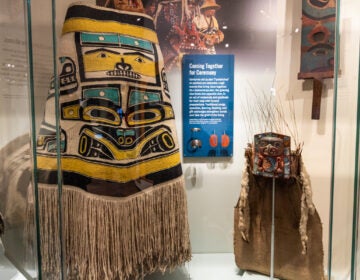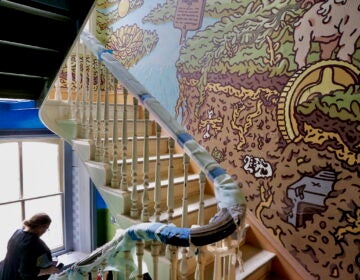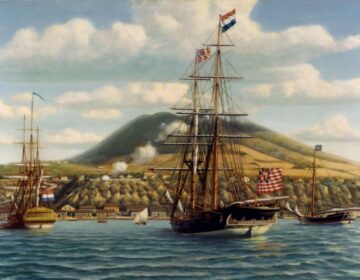‘A Philadelphia story’: Art museum traces Matisse’s transformative decade
Once used as fighting words during the recent PMA strike, “Matisse in the 1930s” opens, tracing a transformative decade in the life of Henri Matisse.

File photo: Philadelphia Museum of Arts is opening a new department for African and African Diasporic art. (Emma Lee/WHYY)
For the last three weeks, the French modernist artist Henri Matisse, dead for 68 years, played a significant part in the contract negotiations between the Philadelphia Museum of Art and its striking union workers.
With the opening date of “Matisse in the 1930s” approaching, workers picketing outside the museum chanted “No contract, no Matisse,” promising to disrupt the exhibition.
No contract, No peace. No contract. No Matisse. @PMA_Union ULP strike continues at the Philadelphia Museum of Art #PMAstrike pic.twitter.com/OrSGnZLzGm
— Philadelphia Museum of Art Union (@PMA_Union) September 26, 2022
With less than a week to go before the Matisse exhibition opening, and the day before a preview gala for major donors and trustees, museum management offered a contract proposal that the workers approved Sunday.
The strike is now over and the workers have returned to their jobs. The Matisse exhibition opens to the public on Thursday.
So, what’s the big deal about “Matisse in the 1930s”?
“It’s no overstatement to say that this was one of the greatest, catalytic turning points in the career of one of the greatest, most renowned artists of the 20th century, Henri Matisse,” said Matthew Affron, curator of modern art at the PMA.
“Matisse in the 1930s” is a major curatorial achievement for the museum, the result of a seven-year partnership with two museums in France: the Musée de l’Orangerie in Paris, where the artist found fame, and the Musée Matisse in Nice, where he lived in his later years. The PMA will be the only museum in the U.S. to host the exhibition.
“This is really a Philadelphia story,” said Affron.
In 1930, a then-61-year-old Matissse was in a creative slump. The painter and sculptor was by then a major figure of French modernism and had found success painting figural interiors, often pictures of women reclining in sumptuously decorated rooms, in an impressionist style. The exhibition features several examples of these odalisque pictures.
But in the late 1920s his productivity had slowed considerably. “The need to paint had gradually slipped away,” according to the exhibition text.
In 1930, Matisse traveled to Philadelphia and met with collector Albert Barnes, who a few years earlier had opened his now-famous galleries in Lower Merion. Barnes commissioned him to paint a mural to fit inside three architectural arches. That commission for “The Dance” pushed Matisse into new ways of image-making, igniting a new creative period.
“He went from a relatively naturalistic style of painting in the 20s — a style of painting based on the observation of light and of space and of figures and of interiors in a relatively realistic way — past the Barnes mural to a new style,” said Affron. “Which found new ways to correlate subjects with very strong visual forms in extraordinarily new experimental ways.”
One of the galleries in the exhibition is filled with Mattise’s studies and preliminary drawings of “The Dance,” in which he worked out the composition by cutting out pieces of paper into geometric shapes, and pushing them around the mural’s arched parameters to find a way to make his abstract figures fit.
Matisse also began to embrace photography in his studio, documenting the progress of a painting then studying the sequence of photos to better understand the essential parts of the picture.
The collage and photography technique offered Mattise a way to put aside realism and think about images in more abstract ways. Figures could be composed of simple shapes and colors; interiors could be based on patterns.
“Matisse used the making of the dance to lay new foundation for his art, to reformulate and radicalize his former creative process,” said Claudine Grammont, director of the Musée Matisse in Nice. “And to re-insert his art into the intellectual and artistic trends of the decade.”
Matisse did not give up on painting ladies in repose. “I do odalisques in order to do nudes,” he once said, as quoted in the exhibition. However paintings made after the Barnes commission are more lushly arranged with dress patterns, plants, and décor. The subjects are more the artist’s painterly invention than the figure.
After the Barnes commission, Matisse returned to Nice where he met his muse, Lydia Delectorskaya, a Russian model who became Matisse’s model, studio manager, and a collaborator. The exhibition features “Woman in Blue,’ a portrait of Delectroskaya in a blue skirt, and next to it the actual skirt she sewed and wore for the picture.
In the 1930s, Matisse was commissioned to make paintings that were to be used to make woven tapestries. In 1935, he painted two large-scale works — “Papeete – Tahiti (Tahiti 1)” and “Window at Tahiti II” — based on etchings he made in Tahiti, which are window-sized works that appear to look out over a terrace at a harbor.
Matisse also began to work in performance, collaborating with dancer and choreographer Léonide Massine to design the sets and costumes of the ballet “Rouge et noir.” The exhibition features film footage from the 1930s documenting the ballet performance.
By the end of the decade, this period of creative freedom and exploration began to close in.
In 1939 his wife Amélie suspected Matise of having an affair with Delectroskaya and left their 41-year marriage.
World War II broke out, and in 1940 the Nazis occupied Paris. Mattise left Paris but chose to remain in France at his studio in Nice during the occupation rather than flee to Brazil.
In 1941, he was diagnosed with cancer. He had a successful surgery but one that left him with serious complications that kept him bedridden for months. During his convalescence, he began making simple line drawings. The exhibition features a selection of drawings from his series “Themes and Variations,” made during this time.
It wraps up the exhibition’s exploration of Matisse’s crucial decade, the 1930s.
“A moment for a titan of the art world really going within himself to understand what his own future would be,” said the PMA director Sasha Suda.
What happened next in Matisse’s immediate future was “Jazz,” a series of paper cutout collages made as a limited edition art book, which he worked on with Delectroskaya. Paralleling the PMA exhibition, the Athenaeum, a historic membership library in Philadelphia’s Washington Square, will put on display pages from its original copy of “Jazz,” opening Nov. 7.
“Matisse in the 1930s” will remain on view at the Philadelphia Museum of Art until Jan. 29, after which it will travel to the PMA’s partner museums in France.

Saturdays just got more interesting.
WHYY is your source for fact-based, in-depth journalism and information. As a nonprofit organization, we rely on financial support from readers like you. Please give today.







